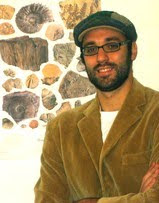Fossils are
not only palaeontological objects, but evocative cultural symbols.
For instance,
the French Romantic composer Camille Saint-Saëns wrote The Carnival of the
Animals, a musical suite of fourteen movements, among which ‘fossils’. The sharp, vibrant sound of the xylophone represent magnificently the
idea of fossil bones, analogously to Saint-Saëns’ Danse Macabre. Indeed the composer had a parodical intent, and alluded to many popular themes of his own times: Twinkle
Twinkle Little Star, Au clair de la lune, J'ai du bon
tabac, Partant pour la Syrie, as well as Rossini's Una voce poco fa. As Hazel Gertrude Kinscella wrote in her Music and Romance, “Saint-Saëns took the opportunity
to ridicule certain too-well known (as he asserted) melodies both of his own
and other’s writings”. Melodies as musical fossils.
The 'musical fossils' of Camille Saint-Saëns.
In more recent times, a contemporary artist embraced the same concept. In fact, Christopher Locke 'fossilized' some technological artifacts of our recent times, including a cassette tape, a walkman and a Nintendo controller. The artist used binomial nomenclature to refer to his own creations (i.e. the walkman is named Ambulephebus sonysymphonia).
 |
| Asportatio acroamatis, a modern fossil by Christopher Locke. |
 |
| Modern fossils: Locke's
Repondicium antiquipotacium, or the 3.5'' floppy disk.
|
“Most
people attribute the shortened lifespan to aggressive predators or accelerated
evolution, but this is not necessarily true. It has been shown recently that
the true demise of most of these specimens came from runaway consumerism and
wastefulness at the high end of the food chain”.
Modern fossils are a paleobiological metaphor realized with a very special process. According to the website of Christopher Locke, "these items are reproduced in a proprietary blend of concrete and other secret ingredients, giving them the look and feel of real stone fossils".
Modern fossils are a paleobiological metaphor realized with a very special process. According to the website of Christopher Locke, "these items are reproduced in a proprietary blend of concrete and other secret ingredients, giving them the look and feel of real stone fossils".
 |
| The rotary dial telephone, or, according to Locke's nomenclature, Deferovoculae circumdactylos. |
 |
| Hilarofustis atarium: the Atari joystick, fossilized by Christopher Locke. |





